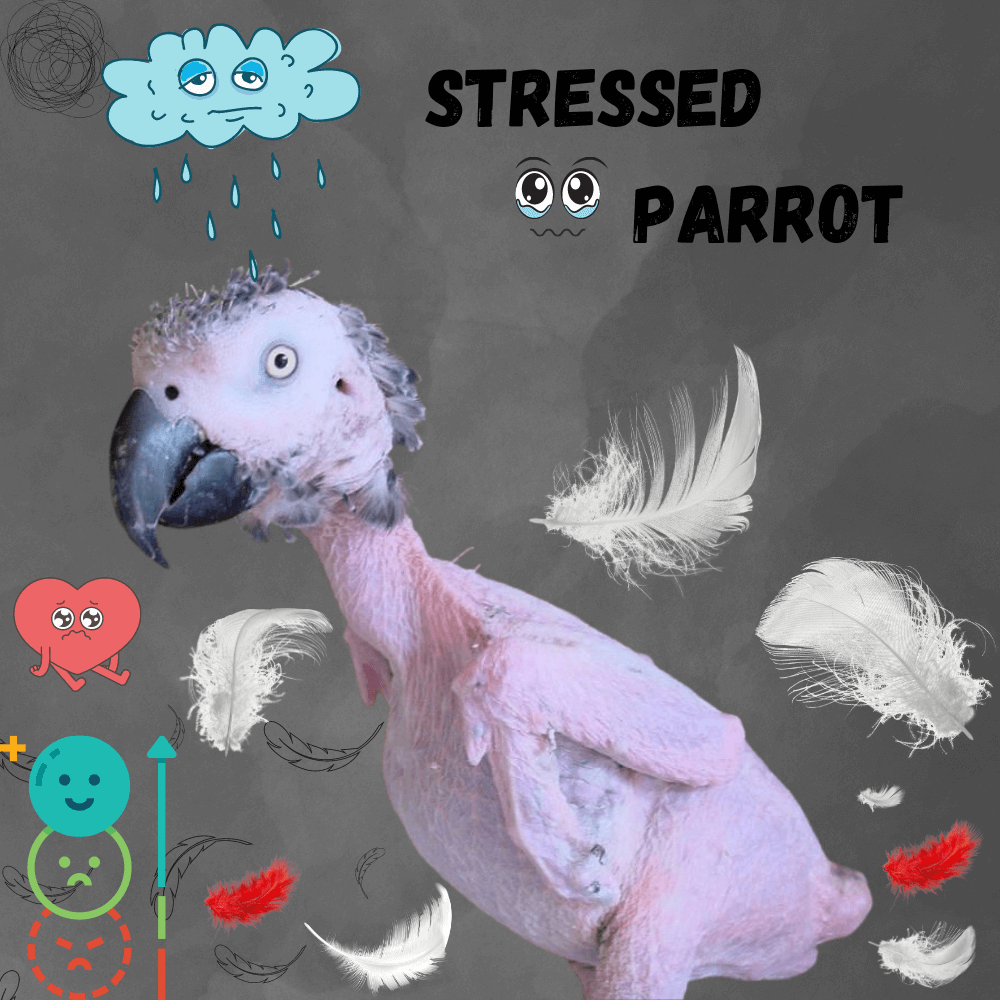For this reason, you might also consider working with a veterinarian or a bird trainer; they may have useful information to help your pet more quickly. Here’s everything you need to know about parrot stress and how to manage stress levels in your home.
How to tell if a parrot is stressed
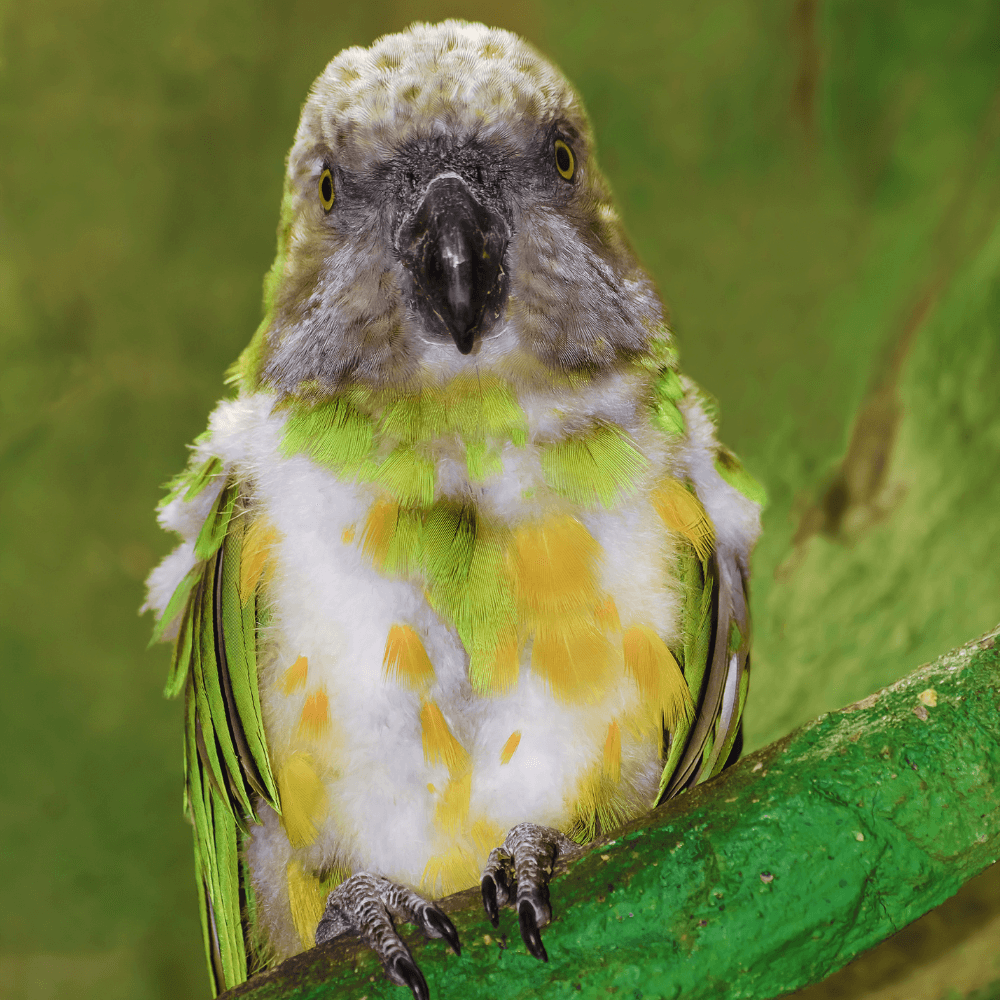 stressed parrot
stressed parrot
House parrots from the family Psittacidae are being kept more and more frequently in private households.
However, despite their reputation for being friendly and social animals, not all owners realize that they require lots of attention, a large cage, companionship, and a continuously stimulating environment.
Due to a lack of care in some households, it is not uncommon for a parrot to develop stress.
You might also be interested in the article The Surprising Cognitive Abilities of Parrots
According to a Japanese study (linked here), up to 11.7% of pet parrots damage their feathers, which is a clear sign of stress and emotional tension. Cockatiels and lovebirds seem to be affected the most, but they can occur in virtually any captive bird. Some of the most obvious signs of this are as follows:
- Excessive vocalizations: This can include repeated screaming, frequent alarm calls, or chirping.
- Self-Mutilation: the self-destruction of feathers. A stressed parrot will pull out the feathers on its body, but will not reach the feathers on its head. If feather loss occurs all over the body (including the head), other diseases must be suspected.
- Stereotypical behavior: For example, shaking your head or constantly rocking back and forth. These are repeated acts that make no sense from an ethological point of view.
- Excessive sleepiness or withdrawn anxious behavior. The bird may also be crouching at an angle.
- Fear: The bird will flee or hide from its owner, even though it is otherwise confident and social.
- Aggressive Behavior: The bird shows aggression towards people and other birds. He hits the cage bars or bites into them.
- Other signs: Hissing, panting, a fanned tail, wings spread away from the body, or cocked head feathers can also be signs of stress.
- Increased respiratory rate: This may include panting or open-billed breathing.
- Territorial Behavior: The bird can become aggressive towards other housemates, although it has not previously been so.
Also read this article Depression in Parrots: Causes, Symptoms and Treatment
Is Your Parrot Stressed? How To Tell By Your Bird’s Feathers
SOURCE: MARLENE MC’COHEN
Causes of stress in parrots
As you can see, anxiety in parrots is far more common than you initially thought. In the following paragraphs, we will go into the most important reasons that can cause stress in the bird.
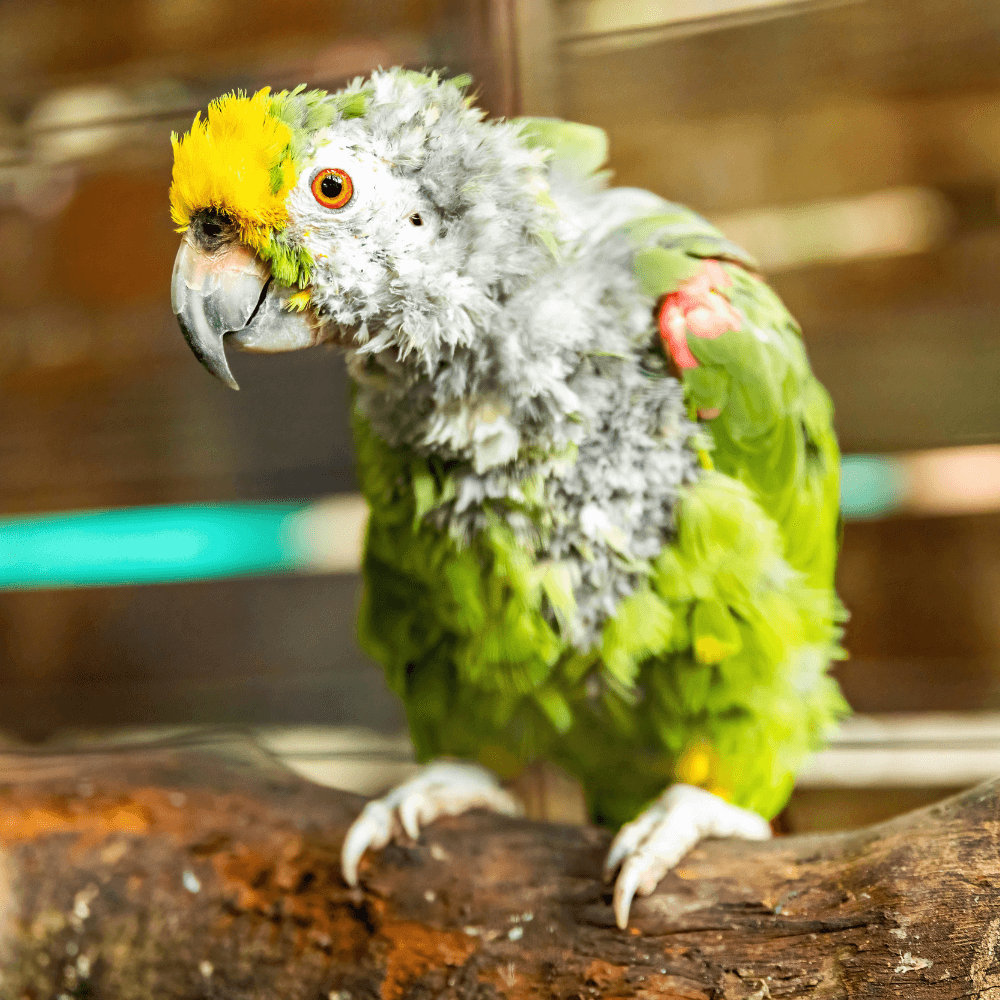 stressed parrot
stressed parrot
Environmental factors
In the wild, parrots are accustomed to traveling long distances each day to forage and reproduce. Likewise, they mostly live in humid, rainy environments with warm temperatures. As you can imagine, life in a cage bears little resemblance to the natural conditions in which these animals thrive.
Some of the environmental factors that can cause stress in parrots:
- The cage is too small: It depends on the species of bird, but ideally, the cage should be 1.5 to 2 times larger than the diameter of the bird with its wings outstretched. If the height is 60 centimeters, then the cage should be 1.20 meters wide and even higher than this measurement.
- A dirty environment: Remove all uneaten food every 24 hours and change bedding every 24-28 hours. A thorough cleaning of the cage once a week is also recommended. Otherwise, the animal could be stressed by the unsanitary conditions.
- Too low temperatures: The ideal temperature for most parrot birds is between 20 and 25 °C. If it is permanently too cold, the animal will get sick.
- Constant Changes in Daily Routine: Parrots are settled in their habits and don’t like changes in their daily routine.
How about the article Behavior in Cockatoos: Everything You Need to Know About It
Physical factors
Stress can be both a cause and a consequence of physical discomfort in parrots. An animal struggling with a painful infection will constantly feel unwell. However, anxiety can also be the cause of physiological disease. In any case, you should allow the bird at least 2-3 hours a day outside of its cage to exercise its muscles and wings.
Another important physical factor is extended rest periods. A parrot that doesn’t sleep well will sooner or later show signs of stress.
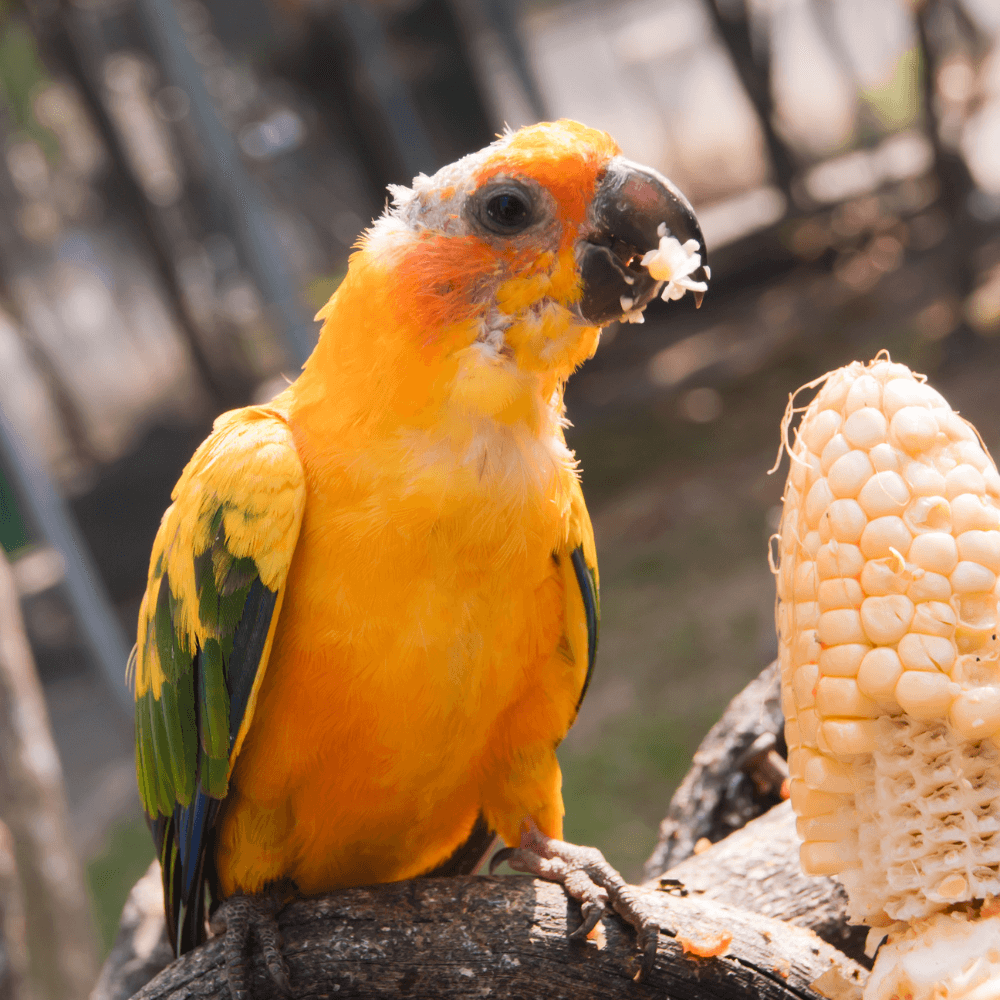 stressed parrot
stressed parrot
Mental factors
Parrots are extremely intelligent animals. Therefore, as we have already mentioned, they need constant mental stimulation.
Otherwise, they develop self-injurious behavior, stress, aggression, or other negative behaviors. The stereotypes mentioned above are among the most important signs of emotional anxiety in these birds.
When the parrot compulsively repeats a behavior pattern for no reason, it’s always a serious sign.
Social factors
Some parrot birds, such as B. Lovebirds and parakeets, are social birds, they live in monogamous pairs throughout their lives. That is why it is recommended to always keep a pair in the same cage.
The situation is similar with larger species (e.g. gray parrots), but again you have to pay attention to the size of the “enclosure”. If the animals don’t have much space, they will attack each other.
If your parrot lives alone in its cage, you will need to spend at least 2-3 hours a day with it. He should also have items he can use to while away the time when you’re not around.
Can you prevent stress in your parrot?
While stressing your parrot is inevitable, it’s important to pay attention to any cues your pet may be giving you.
The most important thing is to avoid sudden lifestyle changes as much as possible. In order to achieve this goal, it is important to know the sensitive areas in general before making any changes.
More on the subject here The faithful budgerigars: a life with the same partner
Parrot cage
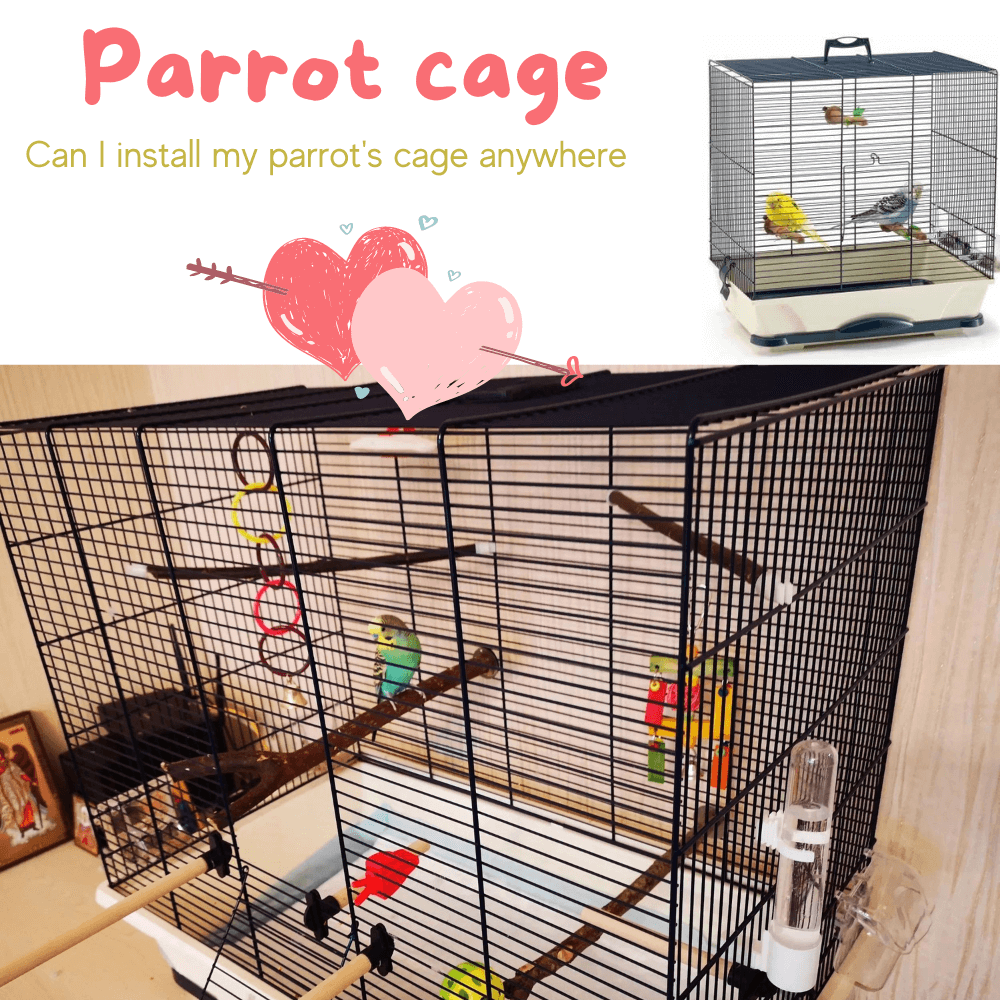
A parrot’s cage should ideally be placed in an area of the room that gives the bird a view of its surroundings. The location should also provide an opportunity to use part of the cage for retreat and privacy, e.g. B. on a wall or in a corner of the room.
For extremely shy birds, one side of the cage should be partially covered with a towel or blanket to create a retreat area. In any case, you should avoid placing the cage in the middle of the room, on the floor, or in noisy or busy areas.
It’s also very important not to place the cage directly in front of a window, as other birds or stray animals may startle your parrot. In addition, it is usually colder in such places than in other sheltered places.
Parrot care
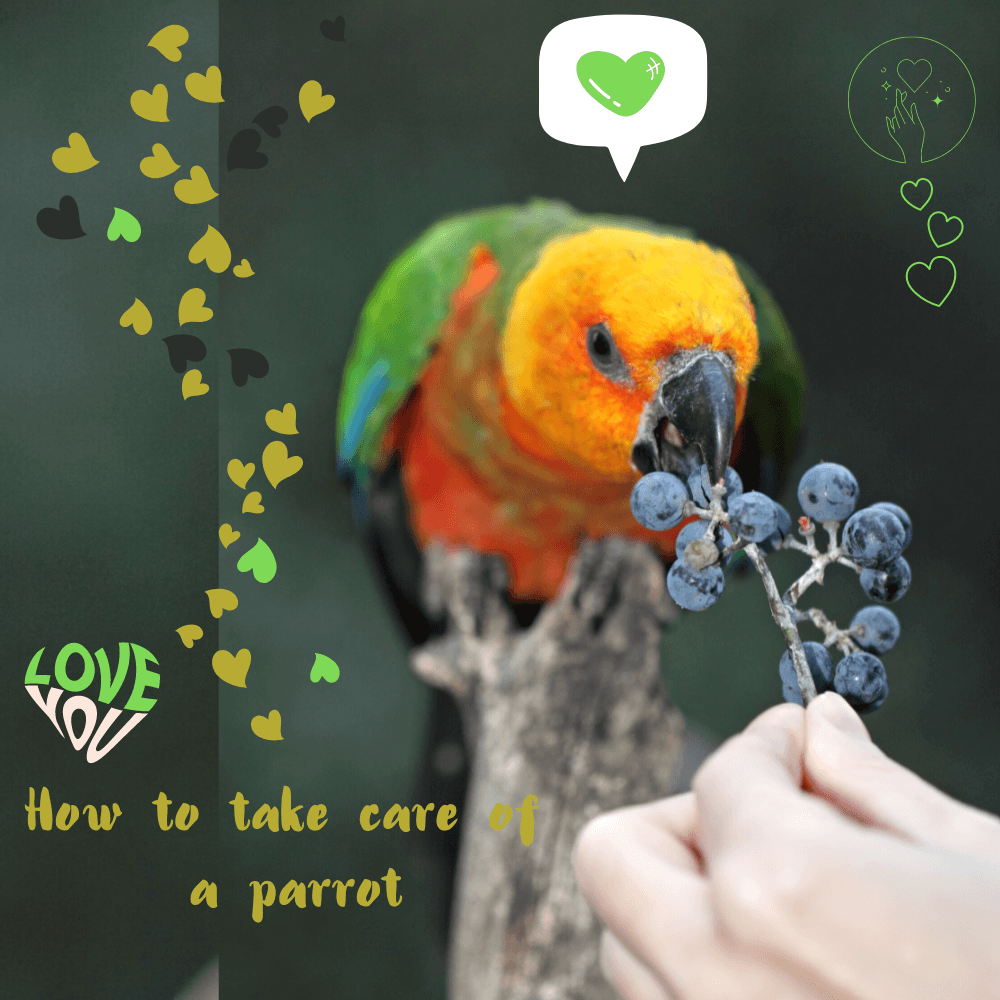
Make sure you can maintain a consistent routine of grooming, feeding, and socializing. While it may seem obvious, your parrot’s cage should always be covered at night. As we have already mentioned, a tropical parrot needs a lot of sleep (up to 12 hours) to avoid stress.
Be treated kindly
Also, keep in mind that birds (when they are prey animals in the wild) are often startled by sudden movements and loud noises. Therefore you must approach the birds in a calm manner and speak in a soft tone. Keep the following tips in mind:
- move slowly. If your bird attacks you because it’s scared or nervous, moving away quickly can upset it even more.
- Use a stick to train him. If your parrot doesn’t like being handled but you want to help him be more social, offer him a stick instead of your hand. If you’re not making progress with him, see a professional animal trainer.
- Don’t startle the animal. Don’t try to stare or look into the cage with an element of surprise. Also, avoid handling your bird with a hat or gloves, as it may not recognize you and may feel threatened.
- Other unwanted items. Some birds are startled by brooms, hoses, boxes, or other unfamiliar objects – especially when they move. Keep them away from the cage and remove the items completely from the room when the birds are roaming around freely.
Also read the following article Parrots, funny companions of man
Parrot activities
Talk to your pet often. Challenge your bird with stimulating toys, a television, radio, or anything else exciting to pique their interest. It is often recommended to change toys and stimulating objects every week.
Your bird will also benefit from your attention if you give it more time outside of its cage. During this time he can move and stretch his wings to their full span. Of course, the area where you release the bird should be safe.
The bird should also not be able to escape to freedom. The “free time” should be at least 2-3 hours a day. You can of course extend this period of time as long as you like (while respecting the animal’s desires and bedtime).
As swarm animals, birds enjoy the company and feel comfortable with conspecifics. Monogamous animals prefer to live in pairs. These birds should not be kept alone unless there are medical reasons not to do so.
If there are problems with aggressive behavior, you may have to find another solution. If you only have one parrot in your home, you should definitely give it as much attention as you can on a daily basis.

